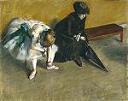
The lessons in the Performing Arts in Art Curriculum explore works of art that depict subjects related to music, storytelling, dance, and theater. Lessons in this interdisciplinary curriculum engage students in diverse topics in the disciplines of visual art, performing arts, history, and language arts.
Beginning-level activities address elementary school standards, intermediate activities address middle school standards, and advanced activities address high school standards. However, middle and high school teachers can use less advanced activities in warm-up discussions or to review basic principles.
|
 |
|
 |
 |
Lessons 1-9 of 12 |
 |
 |
 |
 |
 |

  |
 |
The Art and Accessibility of Music (Beginning Level)
Grades/Level: Lower Elementary (K–2), Upper Elementary (3–5)
Subjects: Visual Arts, History—Social Science, Music
Lesson Overview: Students will discuss a page from a late-medieval choir book, including its function and how it was made. They will learn how music was notated in the Middle Ages and practice a simplified method of notating music. Working in teams, students will create a class choir book of songs of celebration.
|
 |
 |
 |
The Art and Accessibility of Music (Intermediate Level)
Grades/Level: Middle School (6–8)
Subjects: Visual Arts, History—Social Science, Music
Lesson Overview: Students will discuss the form, function, and decoration of an ancient Greek wine cup. They will learn about the importance of music in the daily life of ancient Greeks. They will discuss a page from a late-medieval choir book and compare and contrast the role of music in antiquity, the Renaissance, and today. They will create cups for a social gathering inspired by ancient Greek symposia, and create and perform a song, poem, or story.
|
 |
 |
 |
The Art and Accessibility of Music (Advanced Level)
Grades/Level: High School (9–12)
Subjects: Visual Arts, History—Social Science, Music
Lesson Overview: Students will learn about the jazz singer Billie Holiday and the sociohistorical context in which she performed. They will learn how discriminatory statutes (called Jim Crow laws) affected daily life. They will also analyze how movement is created in photographs and the effect of a photographer's point of view on composition. Finally, students will photograph a musician, paying attention to what can be communicated through point of view.
|
 |
 |
 |
The Art and Ancient Tradition of Storytelling (Beginning Level)
Grades/Level: Lower Elementary (K–2), Upper Elementary (3–5)
Subjects: Visual Arts, English—Language Arts, History—Social Science
Lesson Overview: Students will discuss what is communicated in an ancient statuette by analyzing the size and poses of two figures. They will learn that stories were passed through oral tradition in ancient times. They will create sculptures of themselves, a companion, and a favorite musical instrument using spheres and cylinders, and then recite a story inspired by their sculptures.
|
 |
 |
 |
The Art and Ancient Tradition of Storytelling (Intermediate Level)
Grades/Level: Middle School (6–8)
Subjects: Visual Arts, English—Language Arts, History—Social Science
Lesson Overview: Students will learn about the Trojan War and the hero Achilles. They will compare different stories that were inspired by Achilles, which were passed down orally. They will analyze stories of Achilles in a relief on an ancient sarcophagus and in a drawing by a Renaissance artist. Finally, they will create their own drawing of Achilles inspired by literature.
|
 |
 |
 |
The Art and Ancient Tradition of Storytelling (Advanced Level)
Grades/Level: High School (9–12)
Subjects: Visual Arts, English—Language Arts
Lesson Overview: Students will analyze scenes from the Trojan War that are visually depicted in an ancient object and an 18th-century painting. They will research an epic poem inspired by the Trojan War and write a literary response analyzing how themes and values in the poem reflect the historical context in which they were made. Finally, they will work in teams to reframe a tale from the Trojan War in a contemporary context—visually and in poetry—and recite the tale in a poetry slam.
|
 |
 |
 |
The Art and Depiction of Dance (Beginning Level)
Grades/Level: Lower Elementary (K–2), Upper Elementary (3–5)
Subjects: Visual Arts, Dance
Lesson Overview: Students will learn about an artist's sketchbook that includes drawings of ballet dancers. They will practice two ballet steps and discuss how an artist uses line to depict dancers in rehearsal. Students will make a sketchbook and produce a series of quick sketches of dancers.
|
 |
 |
 |
The Art and Depiction of Dance (Intermediate Level)
Grades/Level: Middle School (6–8)
Subjects: Visual Arts, Dance
Lesson Overview: Students will learn about axial movements and locomotor movements by discussing dancers depicted in a drawing and photograph. They will then practice combining axial and locomotor movements. They will describe how artists depict a dancer's motion in drawing and photography. They will also analyze how an artist creates movement and emphasis through contrast, composition, and leading lines, and then experiment with photography to capture motion in dance.
|
 |
 |
 |
The Art and Depiction of Dance (Advanced Level)
Grades/Level: High School (9–12)
Subjects: Visual Arts, Dance
Lesson Overview: Students will examine three works of art to learn about the daily lives of working ballet dancers in Paris in the 19th century. Students will conduct additional research to learn about the cultural context at the time these dancers worked, including how ballet dancers were perceived. Finally, students will create a backstage view of a contemporary dancer.
|
 |
 |
 |
 |
 |
 |
Lessons 1-9 of 12 |
 |
 |
 |
 |
 |

  |
 |








